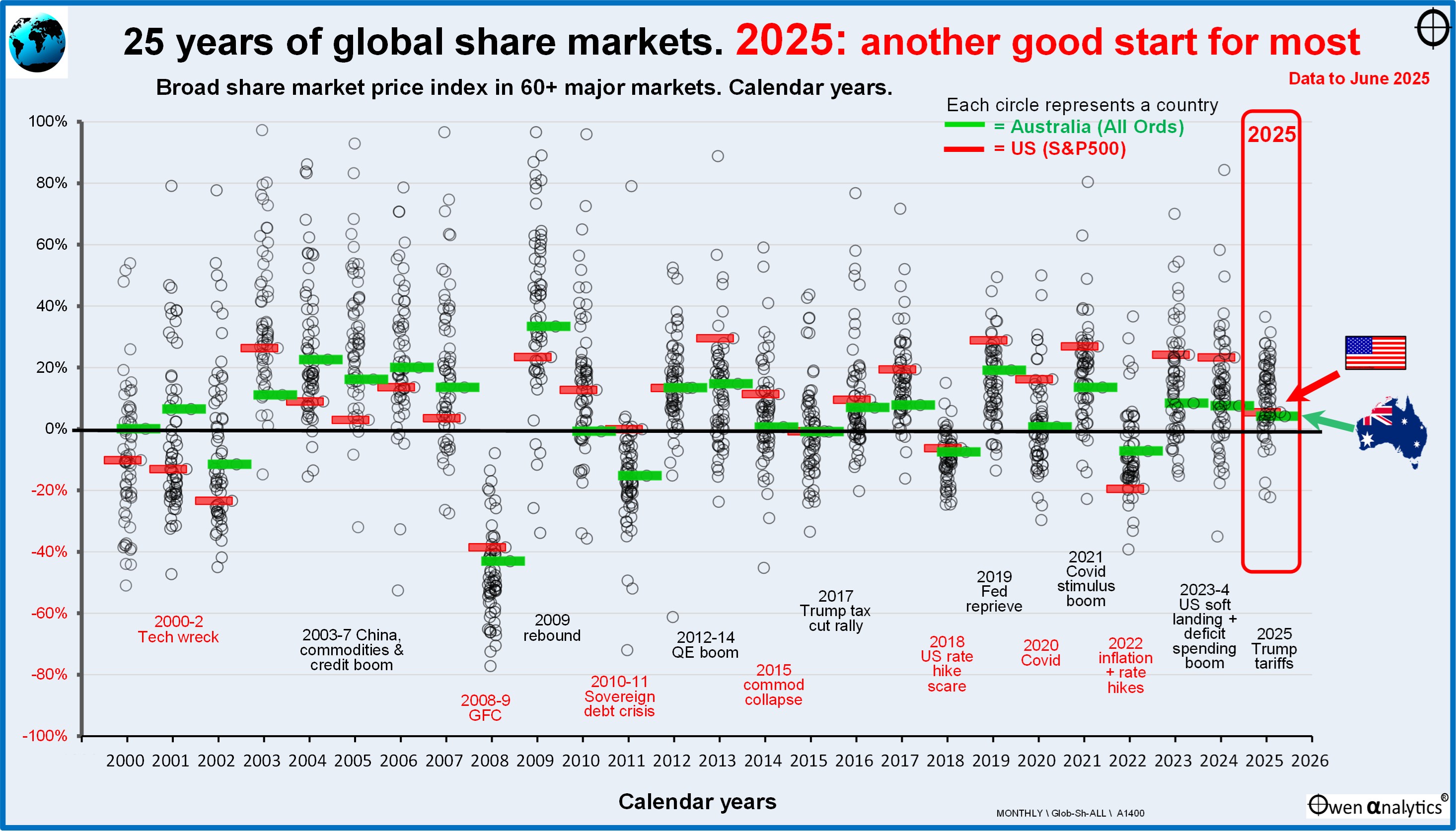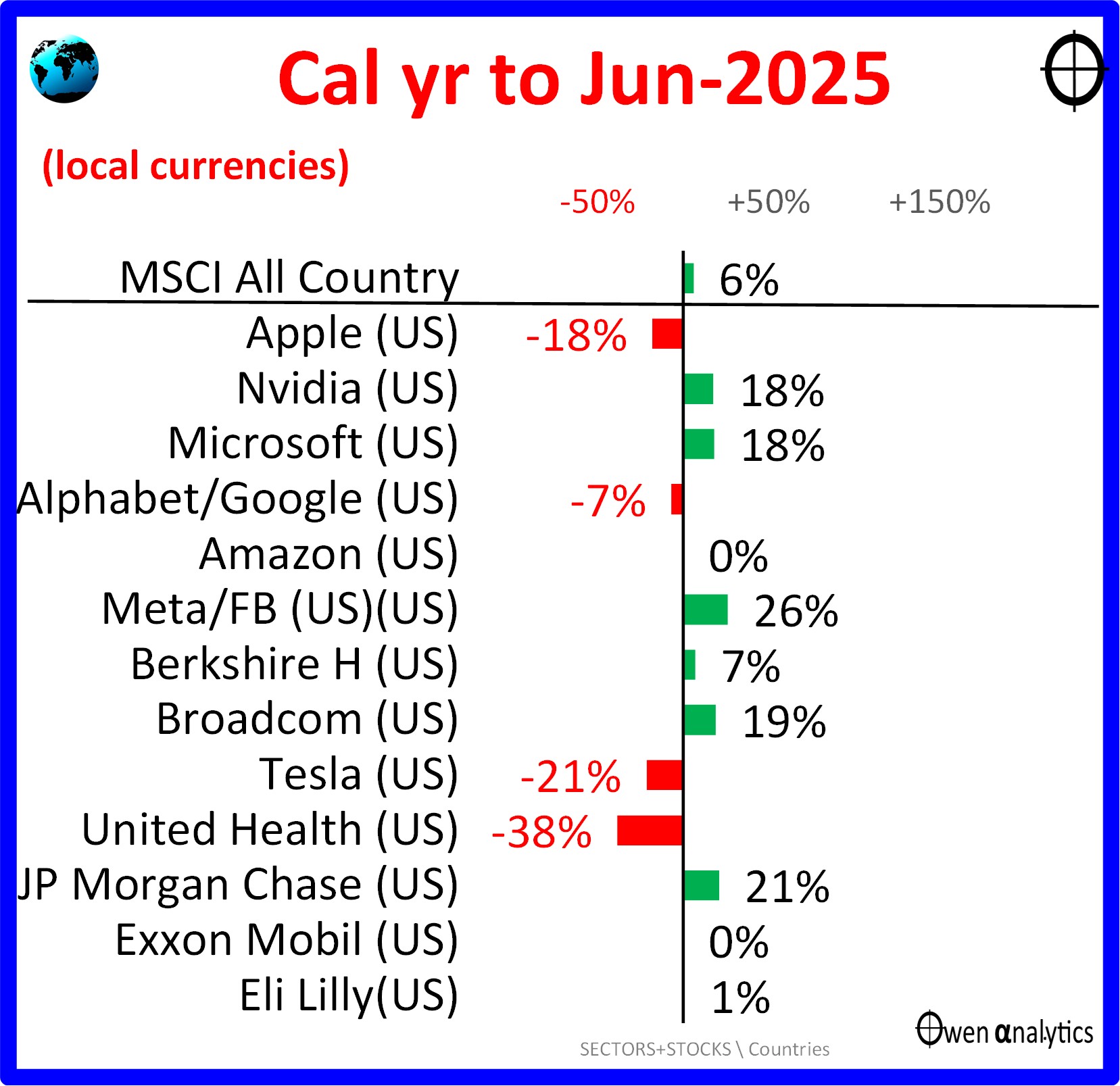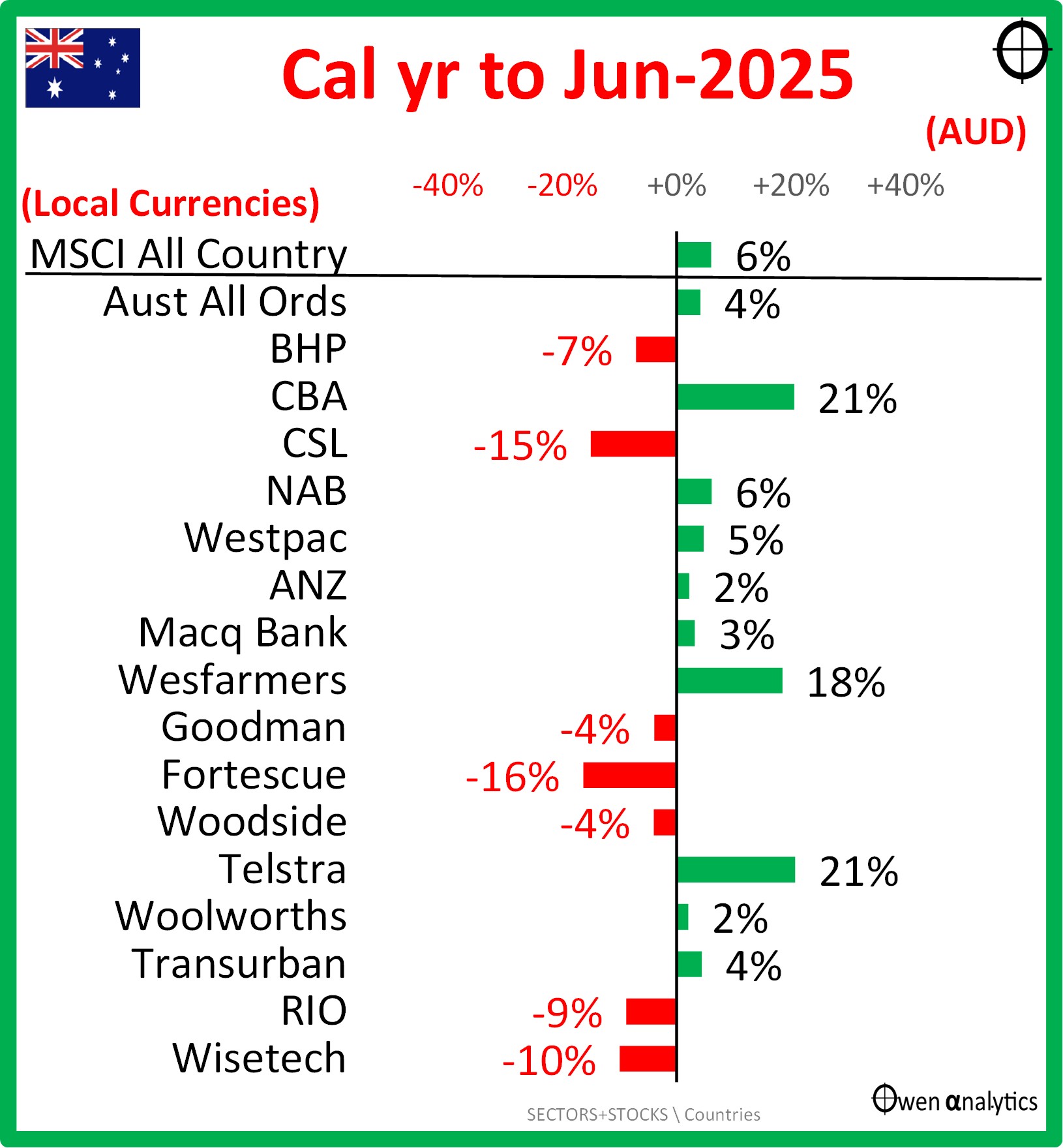Key points:
- In first half of 2025 - 80% of world share markets are up, and 57% are up by more than 10%.
- A good start to another good year despite a constant chorus of wrong predictions of imminent recessions and corrections by economists and ‘expert’ commentators.
- It’s been a broad global rally, NOT just ‘US big-tech’ lifting the world.
- Can the rally continue? There have been plenty of longer rallies in the past!
Today’s chart shows gains/losses per calendar year since the start of this century for the main share market price index in local currencies for 65 major global share markets I cover.

Each circle represents a country share market. I have highlighted the US (S&P500) as red bars, and Australia (All Ordinaries index) as green bars, so we can see where they are in the pack in each year.
First half of 2025
In first half of 2025 - 80% of share markets are up, and 57% are up by more than 10%. So it is NOT just a case of the ‘US big-tech lifting the world’ which is the media narrative for the past couple of years. Almost everywhere is up in the broad global rally that started in late 2022 after the 2022 rate hike sell-off.
For three years now, the majority of economists around the world have been repeatedly predicting US/global recessions, and especially this year with Trump’s tariff wars.
Fortunately, we don’t let armchair economists manage actual money!
Best & Worst
Best so far in 2025 is Slovenia +36%, Poland +31%, South Korea +28% (Samsung recovering some of last year's big fall due to corruption/political scandals).
(Off the chart completely is Venezuela at +212% which I ignore for this purpose because inflation is running at 170%)
Worst so far this year is Thailand down -22% (Trump tariffs). Also down are Argentina -21% (Milei’s austerity regime), and Denmark -17%, mainly due to slide in Novo Nordisk (Ozempic).
US market
USA (S&P500) is ranked 43rd out of 65 markets this year, with a gain of +5% to June 2025 (The Dow Jones, NASDAQ, Russell3000, and Wilshire indexes are all up by very similar amounts).

The main drag on the US market have been: Apple (growth/tariff concerns), Tesla (Trump’s removal of subsidies for EVs), Alphabet (Google search being eaten alive by ai), and United Health (truck-load of problems).
Australia
Australia (All Ords) is ranked 47th out of 65 markets so far this year, with a gain of +4%. The largest contribution by far to this gain has been the continued mysterious rise and rise of CBA.

The main drag on the local market this year have been from the big iron ore miners (BHP, FMG, RIO) with lower iron ore prices in the China slowdown, and CSL (Vifor problems plus Trump Tariffs).
Australia has lagged the US again in 2025, as it did in 2024 and 2023. Australia has lagged the US in nine out of the last ten years. The only exception was in 2022, when Australia held up better than the US in the 2022 rate hike sell-off.
Can the boom run for even longer?
With two very good years in 2023 and 2024 in the bag, and now a good start to 2025, surely we can’t expect the current global boom to last much longer? (Even after three years of bad forecasts, economists and market commentators are still falling over themselves predicting imminent recession and crash!)
Why not? We’ve seen plenty of prior booms that ran for longer – for example:
- 2019-20-21 - three great years for the US market, despite the fact that right in the middle of it was the 2020 Covid lockdown sell-off and recession, which he sharpest and deepest US and global economic recession since the 1930s.
- 2012-3-4 - another recent rally of three good years in a row (thanks to QE & ZIRP).
- 2003-4-5-6-7 – four positive years (China/credit boom).
Going back further –
- 1995-6-7-8-9 – five positive years in a row – each 20% or better (‘dot-com’ boom).
- 1982-3-4-5-6-7-8-9 – eight positive years in a row (inflation receding, deregulation, take-overs, despite the 1987 crash).
Big booms always end in big collapses
Each of these long multi-year rallies was followed by a big crash of course, but that is how the market works. Irrational over-priced booms never deflate slowly and return calmly back to rational ‘fair value’ prices. Financial markets always lurch from wild swings on the upside to wild swings on the downside because they are run by humans driven by wild emotions, not rational logic.
Yes, we all know the US market is very expensive, but share market booms don’t collapse because, or when, they are expensive. Booms can run on for many years into even more expensive territory before they eventually collapse. The longer and higher the boom, the bigger the eventual collapse. We are into one of those long, over-priced booms now.
Will 2025 be the year the current boom collapses (Trump trade wars? inflation revival? military flare-up? US defaulting on debt?). Or will US tax cuts, deficit spending, and deregulation keep the rally going for another year?
What to do?
What NOT to do is easy - Don’t listen to pontificating economists (they are downright dangerous. Economists can’t even predict the past, let alone the future!)
(You want proof they are obsessed with forecasting the past, and still can’t even get that right? Right now, the current chatter among economists everywhere is about what the June quarter 2025 GDP numbers will be. And what the June quarter inflation numbers will be. June quarter is in the past. It’s gone. Who cares what the June quarter did. As an investor, I’m thinking about the next year or so and beyond, not wasting my time and energy forecasting the past!)
Don’t listen to shrill market/media commentators (they don’t have actual money on the line, and/or they are just pushing a product).
Don’t follow the crowd – in either panic buying/gearing-up/doubling-down if prices suddenly rise ('FOMO' - Fear of Missing Out), or panic selling if prices fall suddenly ('FOLE' - Fear of Losing Everything).
What to do? Actually, same as always!
- Stick to your/(client) strategy, re-assess and re-confirm goals, needs, risk tolerance, cash flow requirements.
- Adjust for any material changes in personal/family circumstances (health, births, deaths, marriages, divorces, inheritances, etc).
- Continually re-assess pricing of assets against underlying fundamental values (profits, cash flows, dividends, rents), be prepared to take profits and/or pick up bargains when opportunities present themselves. This is what volatility is for!
‘Till next time, safe investing!